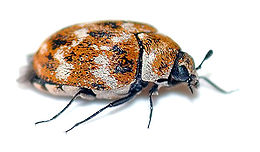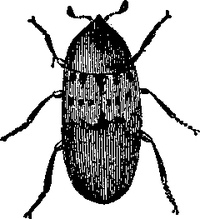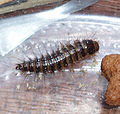- Dermestidae
-
Dermestid Beetles 
Varied Carpet Beetle (Anthrenus verbasci) Scientific classification Kingdom: Animalia Phylum: Arthropoda Class: Insecta Order: Coleoptera Infraorder: Bostrichiformia Superfamily: Bostrichoidea Family: Dermestidae Subfamilies - Attageninae
- Dermestinae
- Megatominae
- Orphilinae
- Thorictinae
- Trinodinae
Dermestidae are a family of Coleoptera that are commonly referred to as skin beetles. Other common names include larder beetle, hide or leather beetles, carpet beetles, and khapra beetles. There are approximately 500 to 700 species worldwide. They can range in size from 1–12 mm. Key characteristics for adults are round oval shaped bodies covered in scales or setae.[1] The (usually) clubbed antennae fit into deep grooves. The hind femora also fit into recesses of the coxa. Larvae are scarabaeiform and also have setae.
Dermestids have a variety of habits; most genera are scavengers that feed on dry animal or plant material such as skin or pollen, animal hair, feathers, dead insects and natural fibers. Members of Dermestes are found in animal carcasses, while others may be found in mammal, bird, bee, or wasp nests. Thaumaglossa only lives in the egg cases of mantids, while Trogoderma species are pests of grain.
These beetles are significant in forensic entomology. Some species are known to be associated with decaying carcasses which help with criminal investigations. Some species are pests (urban entomology) and can cause extensive damage to natural fibers in homes and businesses.
They are used in taxidermy and by natural history museums to clean animal skeletons. Some dermestid species, commonly called "bow bugs," infest violin cases, feeding on the bow hair.
Contents
Forensic relevance
Urban and stored products
Dermestid beetles are destructive to a number of common items. Natural animal fibers such as wool, silk, fur, or feathers are more prone to attack than synthetic fibers.[2] Dermestids are also known to attack chocolate, copra, and cocoa beans.[3] Most damage is done by the larval stage of the beetle, while adults feed on flowers and shrubs.[4]
Medicolegal
 Dermestid beetles being used to clean a human skull at Skulls Unlimited International, Oklahoma City, Oklahoma.
Dermestid beetles being used to clean a human skull at Skulls Unlimited International, Oklahoma City, Oklahoma.
Dermestes maculatus, hide beetles, also have the potential to offer investigators an estimation of the time since death in homicide or questionable cases.[5][6] Similar to the use of flies in forensic entomology, the arrival of D. maculatus to carrion occurs in a predictable succession. Adult D. maculatus beetles generally arrive 5 to 11 days after death.[7] In an attempt to refine this relatively wide range, recent research has repeated arthropod succession studies.[8][9] These studies are applied to estimate the arrival of various species of Dermestidae after death. Development for Dermestids is temperature dependent, and the optimal temperature for D. maculatus is 30˚C. Development data is normalized using Accumulated Degree Days.[10] Dermestids can also be used in cases involving entomotoxicology, where feces and shed larval skins can be analyzed for toxins.
Dermestes maculatus collected from raccoon carcass:
General larval characteristics
Dermestid larvae boast a complete or holometabolous development, which include an egg, larva, pupa, and adult stage. As opposed to ametabolous or hemimetabolous development, the larva's wings start off as internal wing pads and as development progresses, the wings begin to develop externally. Dermestid larvae are profoundly covered with varying lengths of setae that give a general "fluffy" appearance.[11] The larvae are generally dark brown to black and possess a pair of spine like appendages on the terminal end of the abdomen. Most beetle larvae have chewing mouthparts,[12] an obvious head capsule which is sclerotized, as well as 3 pairs of well developed thoracic legs that easily distinguish them from Diptera maggots. The larva's size depends on the species and is typically less than 1/2 of an inch. Most larvae are found on human corpses during the dry and skeletal phases of decomposition, which occurs several days after death.[1][13] Larvae also move away from light and often hide in any cavity in order to remain undisturbed.[1]
Selected taxa
Genera
Larder beetles
The larder beetle, Dermestes lardarius, larva is longer than the adult larder beetle and thickly covered with short and long setae which are reddish-brown to black in color. Along with the coloration is a white undersurface.[14] They also have two spine-like appendages on the posterior end on the abdominal segment. A distinguishing feature of the spine is that it curves backward. The black larder beetle larvae possess the same general characteristics but instead of the spines curving, they extend backward and are not strongly curved.[1] Mature larvae of both species tend to bore into hard substrates such as wood, cork, and plaster in order to pupate.[15]
Larder beetles are infrequent pests of households.[11] Both adults and larvae feed on raw skins and hides. Adult larder beetles are generally 1/3 to 3/8 of an inch long and are dark brown with a broad, pale yellow spotted band across the upper portion of the elytra. Three black dots arrange in a triangle shape on each wing. The sternum and legs of the larder beetle are covered in fine, yellow setae. Adult larder beetles are typically found outdoors in protected areas during the winter but during the spring and early summer they enter buildings. Females lay approximately 135 eggs near a food source and will hatch in about 12 days. The life cycle of larder beetles lasts around 40 to 50 days.[15]
Black larder or incinerator beetle
larder Beetle Scientific classification Phylum: Arthropoda Class: Insecta Order: Coleoptera Genus: "Demestes" Species: ""D.lardarius"" The black larder or incinerator beetle, Dermestes ater, is completely dark with scattered yellow setae on the body. They are similar to Dermestes maculatus but lack a serrated elytra. A distinctive feature is the ventral pattern is yellow instead of white. This beetle is a severe pest of fish, mushrooms, and cheese.[1][15][16]
Hide/leather beetle
The hide/leather beetle, Dermestes maculatus, larvae are longer than their adult beetles. They are slim and altogether covered with short and long setae. As compared to the larder beetle, they are reddish-brown to black in color. In addition, they also possess two spine like appendages on their posterior end on their abdomen. An identifying feature about the spine is that it curves forward unlike the larder beetle.[15]
Hide beetles or leather beetles are also known as the skin beetles. Both adults and larvae of skin beetles feed on raw skins and hides like the larder beetles.[15] This species is distributed worldwide. The hide or leather beetle is similar in appearance to the larder beetle except the forewings are only dark brown and the sternum is mostly white with some black, which is a characteristic feature.[1][16][17] Their life cycle lasts 60 to 70 days and the females can lay up to 800 eggs in their lifetime.[15]
The hide and larder beetles both feed on an assortment of animal protein based products and cause serious damage in the areas of silkworm production and museums.[11]
Carpet beetle
The carpet beetle larvae start to feed as soon as they hatch. They are carrot shaped and heavily covered with setae especially in their posterior end. The number of instars differ from 5–11 and in some cases reach up to 20. The black carpet beetle, Attagenus megatoma, larvae may grow up to 1/2 inch (12 mm) and be yellow to brown in color. Other types of carpet beetles are regularly 1/4 to 1 inch (6 to 25 mm) in length and covered with dark setae. Certain species have distinctive tufts of setae extending from their posterior end. These beetles are attracted to soiled fabrics and crevices where dead insects may serve as a food source.[11][18] The larvae of the carpet beetle are often referred to as "woolly bears" or "buffalo moths".
Black carpet beetle
The black carpet beetle, Attagenus megatoma, is a widely known stored product pest and one of the most destructive because the damage caused to household products containing keratin, which is a protein found in animal hair and feathers.[11][19] They are also able to burrow through various food packaging allowing passage for other insects as well. Females can lay up to 90 eggs and they hatch in about 8 to 15 days. Generally this species only has one generation a year.[11] The time it takes to become an adult varies from 6 months to a year. In addition, an adult black carpet beetle can live up for an additional 2 months.[20] The average adult size is about 2.8 to 5 mm long and they are oval, dark brown to shiny-black in color, and have brown legs.[18][20]
Varied carpet beetle
The varied carpet beetle, Anthrenus verbasci, attacks typical household objects. Carpet beetles are normally associated with things such as carpets, wool, furs, and any processed animal or plant food. Their appetite also includes dead insects, spiders, and even nectar and pollen. They are typically found throughout the United States and Canada[verification needed]. Females can lay up to 40 eggs and the number of larval instars range from 7–8 stages. The time it takes to become an adult varies from about 8 months to a year. In addition, the adults can live around 2 to 6 weeks. This species varies in shape, size, color, and pattern of scales. On average, the adults are 2 to 3 mm in length and have scales that vary from white, brown, yellow, or even gray-yellow.[20]
Khapra beetle
Upon hatching the larvae are around 1.6 to 1.8 mm long and mostly filled with dense setae. Khapra beetle, Trogoderma granarium, larvae contain characteristic body setae such as simple hairs and barbed hairs. Larvae are yellow-white but the head and body setae are brown. As the larvae further develop, their color changes to a golden or reddish brown and the abdomen portion becomes proportionally shorter. The mature larvae reach a maximum length of 6 mm long and 1.5 mm wide.[21]
The khapra beetle is a stored-product pest. Infestations are difficult to control because they crawl into cracks and crevices, remaining for long periods of time.[21] They tend to infest grains and create serious losses on stored products.[1] The adults are covered with setae and are approximately 1.5 to 3 mm long and 1 to 2 mm wide. Male khapra beetles are brown to black with reddish brown markings on the elytra. Females are slightly larger than the males and are lighter in color. The short, 11 segmented antennae has a club of 3 to 5 segments, which fit into a groove on the side of the pronotum.[21]
Control
Hide and larder beetles
Modern methods of meat slaughtering, storage, and distribution have reduced potential infestations of hide beetles. Proper housekeeping is crucial for the prevention of infestations. Dead insects in homes usually attract these beetles because they are a prime food source for hide and larder beetles. Food must be tightly sealed or stored in a refrigerator to avoid any beetle access. Freezing food for a week, heating meat in a pan or microwave for prolonged lengths can kill these insects found in infested foods and prevent them from spreading.[15]
Application of insecticides must be spot treatment to crack and crevice sites where they are suspected of hiding. Pyrethrins are labeled for the use against hide beetles. Also insecticides used for carpet beetles are appropriate to use against hide and larder beetles.[15]
Carpet beetles
Regular cleaning of spilled food or lint will eliminate any sites for potential breeding. Susceptible items like food, woolens, and furs should be stored in an insect proof container. If an infestation is suspected then the source of the problem must be removed and destroyed to further limit any possibility of spreading. These beetles can be killed with extreme heat or exposure to freezers.[22]
Pyrethroid insecticides can be use in order to control carpet beetles. Products containing active ingredients such as permethrin, bifenthrin, deltamethrin, tralomethrin are components of the Pyrethroid insecticide.[22]
Diatomaceous earth is also effective.[23][24]
Image gallery
-
Dermestidae damage to a Manduca quinquemaculata in an insect collection
References
Notes and citations
- ^ a b c d e f g Byrd, Jason. Castner, James (2001). Forensic Entomology: The Utility of Arthropods in Legal Investigations
- ^ P.G. Koehler and F.M. Oi (1991). Carpet Beetles. University of Florida IFAS Extension
- ^ Walker, K. (2008). Hide Beetle. Pest and Diseases Image Library
- ^ Stored Product Pests: Common Hide Beetle. Amalgamated Pest Control.
- ^ Catts, E. P., and M. L. Goff. 1992. Forensic entomology in criminal investigations. Annu. Rev. Entomol. 37: 252–272.
- ^ Goff, M.L., 1993. Estimation of postmortem interval using arthropod development and successional patterns. Forensic Sci. Rev. 5: 82–94.
- ^ Richards, E. N., and M. L. Goff. 1997. Arthropod succession on exposed carrion in three contrasting tropical habitats on Hawaii Islands, Hawaii. J. Med. Entomol. 34: 328–339.
- ^ Vitta, A. et al. 2007. A preliminary study on insects associated with pig (Sus scrofa) carcasses in Phitsanulok, northern Thailand. Tropical Biomedicine 24(2): 1–5 (2007).
- ^ Velazquez, Yelitza. 2007. A checklist of arthropods associated with rat carrion in a montane locality of northern Venezuela. Forensic Science International. 174 (2008) 67–69.
- ^ Richardson, M. S., Goff, M. L., Effects of Temperature and Intraspecific Interaction on the Development of Dermestes maculatus (Coleoptera: Dermestidae. J. Med. Entomol. 38(3): 347–351 (2001)
- ^ a b c d e f Beetle Identification. Pest Solutions Plus.
- ^ Corpse Fauna: Bettle Larvae. Decomposition.
- ^ Forensic Entomology: Use of Insects to Help Solve Crime. Forensic Investigations.
- ^ Larder Beetle. University of Rhode Island Green Share Factsheets.
- ^ a b c d e f g h Lyon, William F. Hide and Larder Beetles. Ohio State University Extension Fact Sheet
- ^ a b Genus Dermestes. BugGuide.
- ^ Stuart M. Bennett (2003). Dermestes maculatus.
- ^ a b Lyon, William F. Carpet Beetle. Ohio State University Extension Fact Sheet.
- ^ Dermestid Beetle. Texas A&M University Entomology.
- ^ a b c Exploring California Insects: Carpet or Museum Beetles.
- ^ a b c Harris, D.L. (2006) Khapra Beetle. University of Florida IFAS Extension.
- ^ a b Cranshaw, W.S. (2000). Carpet Beetles. Colorado University State-Extension.
- ^ Lyon, William F.. "Ohio State University Extension Fact Sheet: Carpet Beetle". HYG-2103-97. Columbus: The Ohio State University. http://ohioline.osu.edu/hyg-fact/2000/2103.html. Retrieved 2009-10-27.[dead link]
- ^ "Black Carpet Beetle". Insect Advice from Extension: Fact Sheets. Penn State University: College of Agricultural Sciences. 2009. http://ento.psu.edu/extension/factsheets/black-carpet-beetle. Retrieved 2009-10-27.
Bibliography
- John M. Kingsolver, "Dermestidae", in Ross H. Arnett, Jr. and Michael C. Thomas, American Beetles (CRC Press, 2002), vol. 2.
- This article incorporates text from the public domain 1911 edition of The Grocer's Encyclopedia.
- Pasquerault, T Vincent, B, Chauvet, B, Dourel, L, , and Gaudry, E (2008). Répartition des espèces du genre Dermestes L. 1758 récoltés sur des cadavres humains (Coleoptera Dermestidae). L'entomologiste Tome 64 N°4 pp 221–224.
- Hinton, H.E., 1945 A monograph of the beetles associated with stored products. 1, 387–395 British Museum (Natural History), London. Keys to world adults and larvae, genera and species; excellent figures, full species information.
- Freude, H.; Harde, K.W.; Lohse, G.A., 1979 Dermestidae. Die Käfer Mitteleuropas 6: Diversicornia (Lycidae — Byrrhidae) 1206 text figs. 367pp. Goecke & Evers. Text in German; the Dermestidae are on pages 304–327.
External links
Categories:- Bostrichoidea
- Insect families
- Dermestidae
Wikimedia Foundation. 2010.










